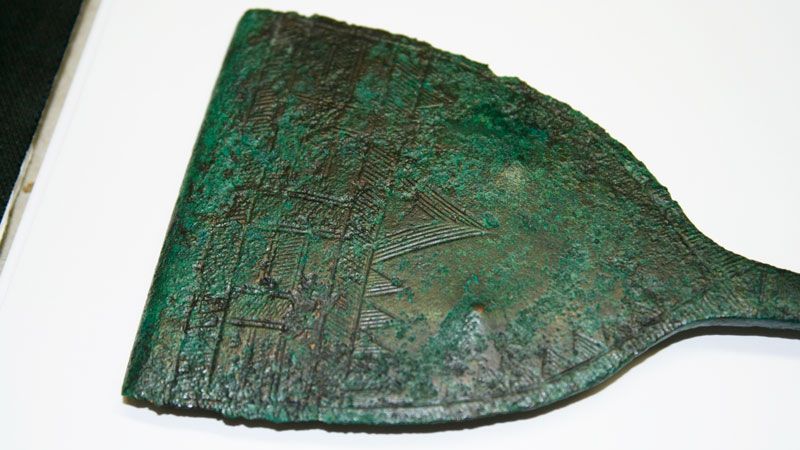
In a first-of-its-kind study, scientists have used ancient DNA to reconstruct the family trees of dozens of individuals who lived in a small German valley around 4,000 years ago.
The genealogies point to social inequality within individual households, which encompassed both high-status family members and unrelated, low-status individuals — possibly servants or even slaves — as well as mysterious foreign females related to no one else.
Such insights could never have been made without using ancient DNA, says Philipp Stockhammer, an archaeologist at the Ludwig Maximilian University of Munich in Germany, who co-led the study. “For me, this is the future of archaeology,” he says. “We are now forced to see social inequality and complexity on a completely different scale, that we haven’t taken into account for the deep past.” The team published its results in Science on 10 October.
Ancient elite
During the Bronze Age, the Lech River Valley in southern Bavaria was packed with small farmsteads, each with its own cemetery. Many of these hamlets were first discovered as the modern city of Augsburg sprawled into nearby countryside during the 1980s and 1990s. Archaeological excavations uncovered dozens of skeletons dating between about 2800 and 1700 BC.
Grave goods from these burials, such as daggers, arrowheads and ornaments, suggest that many Lech Valley inhabitants were well off, although the region lacks the mound-like ‘princely graves’ found elsewhere in Bronze Age Europe. Those often contain huge gold artefacts and show evidence of a social elite, archaeologists say.

To better understand the social structure of the Lech Valley, Stockhammer and Johannes Krause, at the Max Planck Institute for the Science of Human History (MPI-SHH) in Jena, Germany, and their team sequenced DNA from 104 individuals from 13 farmstead cemeteries. They identified six family trees, which encompassed as many as five generations.
Nearly all first- and second-degree relationships the team uncovered were between individuals from the same farmstead; a few, more distant relations were found in different hamlets. These close family members, either male or female, tended to be buried alongside ample stashes of grave goods, suggesting high status was inherited. Cemeteries contained two other groups of individuals who were unrelated to any family members: people with poorly furnished graves, and high-status females.
It is impossible to say whether the low-status individuals represent servants, farm workers or slaves, according to the authors. The social structures of the Lech Valley are reminiscent of those in ancient Greece and Rome, where slaves were considered members of the family unit. “It’s much more complex than we thought for a farmstead around 2000 BC,” Stockhammer says.
The role of the high-status females is even more enigmatic. These women, who were buried with ornaments and jewellery similar to those of the female family members, grew up hundreds of kilometres away, Stockhammer says: the levels of strontium isotopes in their teeth are unlike those present in southern Germany. The levels of these isotopes vary with local geochemistry, and the women showed levels more similar to those found in eastern Germany and the Czech Republic.
But no children of theirs were found in the Lech Valley graves. One possibility is that females travelled hundreds of kilometres to the Lech Valley as part of alliances between wealthy families, and that any children were then returned to their mothers’ native lands. The grave goods of some of the foreign females resemble those of the Únětice culture in the Czech Republic, Eastern Germany and Poland from around the same time.
Who's who
“It’s a really, really beautiful paper,” says Kristian Kristiansen, an archaeologist at the University of Gothenburg, Sweden. “I know we’ll see more of this.” In unpublished work, he and colleagues sequenced DNA from more than 100 individuals from southern Germany and built family trees from the data.
“It does get to the heart of what archaeologists have been trying to do. They spend a lot of time working out who’s related to who in cemeteries,” says evolutionary geneticist Krishna Veeramah at Stony Brook University in New York. But sequencing DNA from hundreds of individuals from a cemetery is likely to cost hundreds of thousands of dollars, he notes, so few archaeologists will have access to the approach until costs come down.
The study marks a shift in how ancient genomics has been applied to archaeology, say Kristiansen and others. Many earlier studies — especially of Bronze Age Europe — sampled large numbers of unrelated individuals spread across dozens of sites in multiple countries. Many studies went on to document profound shifts in the genetic make-up of a region’s inhabitants, to the chagrin of archaeologists who tend to focus on local change and the lives of individuals.
“Instead of talking about a spread of an ancestry, we’re really getting deep into the living history of these people,” says Alissa Mittnik, a geneticist at MPI-SHH and Harvard Medical School in Boston, Massachusetts, who co-led the Science study. She hopes that the profound ancestry shifts that earlier studies identified can be explained in more depth. For instance, her team reports that nearly all women in the Lech Valley had moved away from their families — potentially spreading new cultural practices and ancestry.
And as the number of sequenced ancient human genomes swells into the thousands, researchers will be able to build even bigger ancient family trees and identify distant relatives, just as customers of consumer-genetics firms such as 23andMe and Ancestry.com do today. Some of the individuals studied by Stockhammer, Mittnik and their collaborators turned out to be related to two other Lech Valley inhabitants whose genomes were sequenced as part of a 2015 study of 101 ancient humans. They were from a nearby burial, but, with luck, more distant connections will emerge, Mittnik says. “One day we’ll find where these foreign women in the Lech Valley came from. That would be amazing.”
doi: 10.1038/d41586-019-03046-w